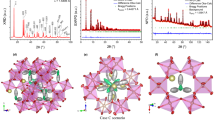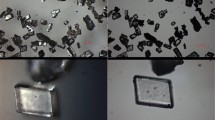Summary
X-ray diffraction studies reveal that most scapolites belong to space groupP4 2 /n. The mean intensity of weak reflections violating body-centered symmetry, reaches a maximum around 37 per cent meionite and extrapolates to zero at the pure end-members. All intermediate scapolites of the marialitemeionite series are pseudobody-centered, and as the composition approaches that of the end-members the structure becomes truly body-centered (I4/m).
The weakh+k+l odd reflections are directly related to (1) orderdisorder of Al and Si in the tetrahedral framework and (2) structural distortion from body-centered symmetry.
Scapolites may be regarded as a continuous, homogeneous solid solution. The cell dimensions are only approximately linearly related to composition and there is a maximum deviation from linearity, for those scapolites (25% Me ≈ 45% Me) whose symmetry departs the most from body-centered symmetry. These phenomena are interpreted in terms of the structural characteristic of the scapolites.
Zusammenfassung
Röntgenbeugungs-Untersuchungen zeigen, daß die meisten Skapolithe der RaumgruppeP4 2 /n angehören. Die durchschnittliche Intensität der schwachen Reflexe, welche der Raumzentrierung widersprechen, erreicht bei 37% Meionit-Momponente ein Maximum — für die reinen Endglieder nähert sie sich dem Wert Null. Alle intermediären Skapolithe der Marialith-Meionit-Reihe sind pseudo-raumzentriert und mit Annäherung der Zusammensetzung an jene der Endglieder wird die Struktur echt raumzentriert (I4/m)
Die schwachenh+k+l ungerade Reflexe stehen (1) mit Ordnung-Unordnung von Al und Si im Tetradergerüst und (2) mit strukturellen Abweichungen von der Raumzentrierung in Beziehung.
Die Skapolithe können als kontinuierliche homogene Mischkristallreihe betrachtet werden. Die Zelldimensionen ändern sich nur ungefähr linear mit der Zusammensetzung; die stärkste Abweichung von der Linearität tritt bei jenen Skapolithen (25% Me bis ≈ 45% Me) auf, deren Symmetrie am stärksten von der Raumzentrierung abweicht. Diese Phänomene werden aus den strukturellen Eigenheiten der Skapolithe interpretiert.
Similar content being viewed by others
References
Bragg, W. L., andE. J. Williams, 1934: The effect of thermal agitation on atomic arrangements in alloys. Proc. Roy. Soc. London A145, 699–730.
Burley, B. J., E. B. Freeman, andD. M. Shaw 1961: Studies on scapolite. Canad. Min.6, 670–678.
Chao, S. H., andW. H. Taylor 1940: Isomorphous replacement and superlattice structures in the plagioclase feldspars. Proc. Roy. Soc. London A.176, 76–87.
Deer, W. A., R. A. Howie, andJ. Zussman, 1963: Rock-forming Minerals,4. New York: Wiley.
Eugster, H. P., H. J. Prostka, andD. E. Appleman 1962: Unit cell dimensions of natural and synthetic scapolites. Science137, 853–854.
Evans, B. W., D. M. Shaw, andD. R. Haughton, 1969: Scapolite stoichiometry. Contr. Min. Petr.24, 293–305.
Gibbs, G. V., andF. D. Bloss, 1961: Indexed powder diffraction data for scapolite. Amer. Min.46, 1493–1497.
Gossner, B., andK. Brückl, 1927: Die Gitterkonstanten von Skapolith und Apophyllit. Zentralbl. Min. Geol. Paläont., Abt. A, Jg.1927, 338–341.
——, undK. Brückl, 1928: Untersuchungen über die Skapolithgruppe. N. Jb. Min., Abt. A, Beilage-Bd. 58, 349–384.
Greenwood, G., 1935: Experiments on piezoelectricity. Z. Krist.91, 235–242.
Haughton, D. R., 1967: A mineralogical study, of scapolite. M.Sc. thesis, McMaster University.
Henry, N. F. M., H. Lipson, andW. A. Wooster, 1961: The interpretation of X-ray diffraction photographs. London: Macmillan.
Jakob, J., R. L. Parker, undE. Brandenberger, 1931: Über einen neuen Skapolithfund im Tessin. Schweiz. Min. Petr. Mitt11, 267–284.
Laves, F., 1950: The lattice and twinning of microcline and other potash feldspars. J. Geol.58, 548–571.
Lin, S. B., 1971: The crystal structure and crystal chemistry of scapolites. Ph.D. thesis, McMaster University.
—— andB. J. Burley, 1973: The superlattice reflection and it relationship to the crystal structure of scapolites. Geol. Soc. Amer., 1971 Annual Meetings, Abstracts with Programs3, 634.
Lin, S. B., B. J. Rurley 1973: Crystal structure of a sodium-and chlorine-rich scapolite. Acta Cryst. (to be published).
Mackay, A. L., 1953: A statistical treatment of superlattice, reflexions. Acta Cryst.6, 214–215.
Morimoto N., andM. Tokonami, 1969: Oriented exsolution of augite in pigeonite. Amer. Min.54, 1101–1117.
Papike, J. J., 1964: The crystal structure and crystal chemistry of scapolite. Ph. D. thesis, Univ. of Minnesota.
— andT. Zoltai 1965: The crystal structure of a marialite scapolite. Amer. Min.50, 641–655.
— andN. C. Stephenson, 1966: The crystal structure of mizzonite, a calcium-and carbonate-rich scapolite. Amer. Min.51, 1014–1027.
Papike, J. J., andT. Zoltai, 1967: Ordering of tetrahedral aluminum in prehnite, Ca2(Al. Fe+3)[Si4AlO10](OH)2. Amer. Min.52, 974–984.
Pauling, L., 1930: The structure of some sodium and calcium aluminosilicates. Wash. Proc. Acad. Sci.16, 453–456.
Scherillo, A., 1935: La meionite del Somma-Vesuvius. Periodico Min. (Roma)6, 227–239.
Schiebold, E., undG. Seumel, 1932: Über die Kristallstruktur von Skapolith. Z. Krist.81, 110–134.
Shaw, D. M., 1960: The geochemistry of scapolite. Part. I. Previous work and general mineralogy; Part II. Trace elements, petrology, and general geochemistry. J. Petrol.1, 218–261.
—, andS. M. F. Sheppard, 1965: The petrology of two zoned scapolite skarns. Canad. J. Earth Sci.2, 577–595.
Ulbrich, H. H., 1971: Space groups, cell parameters and refractive indices of scapolites. Geol. Soc. Amer. Abstracts with programs,3, 736.
Vousden, P., 1954: The determination of pseudosymmetric structures. Acta Cryst.7, 321–322.
Author information
Authors and Affiliations
Rights and permissions
About this article
Cite this article
Lin, S.B., Burley, B.J. On the weak reflections violating body-centered symmetry in scapolites. TMPM Tschermaks Petr. Mitt. 20, 28–44 (1973). https://doi.org/10.1007/BF01082100
Received:
Accepted:
Issue Date:
DOI: https://doi.org/10.1007/BF01082100




